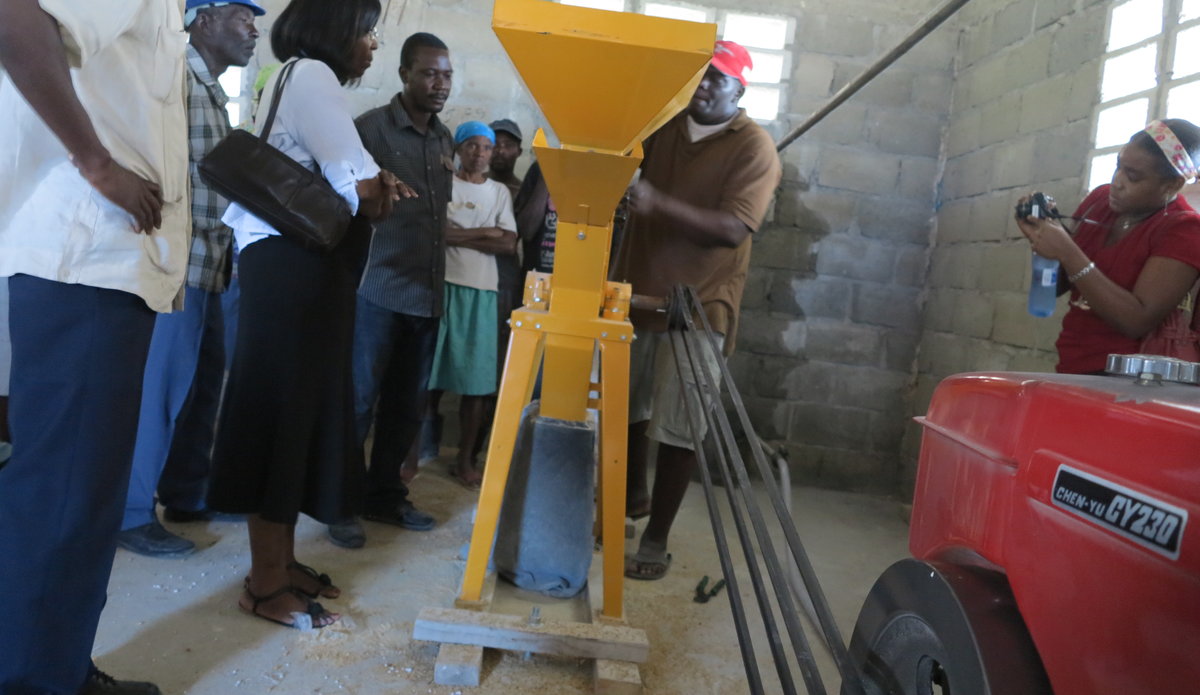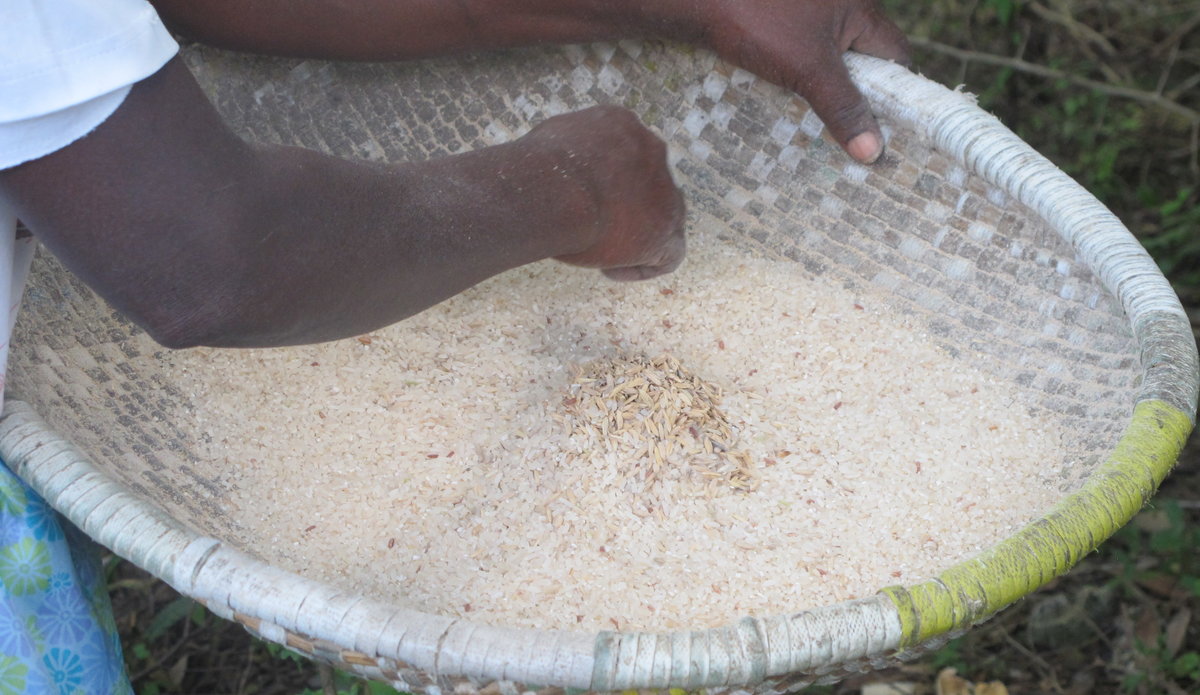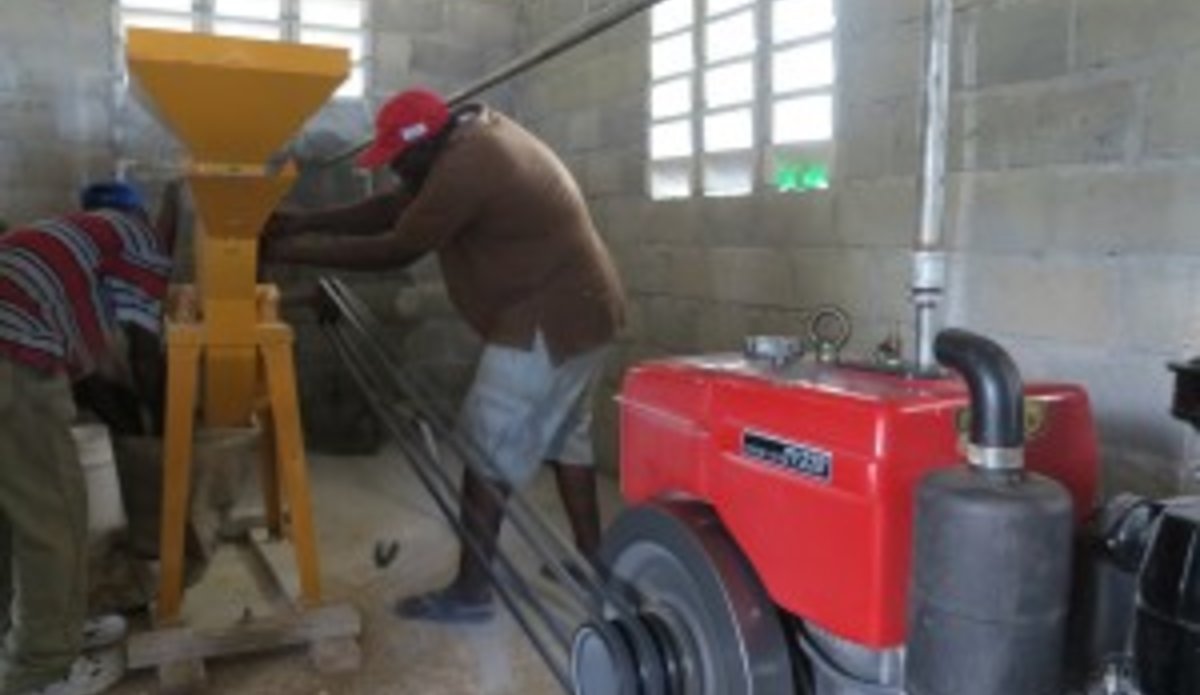A community mill for Damier residentsUn moulin communautaire pour les habitants de Damier
The people of Damier – an area located in the fifth municipal section of Verrettes (Artibonite) - witnessed the inauguration of a rice, millet and maize mill on December 2nd, 2013. This grist mill is a simple apparatus, but one which positively influences the lives of farmers in the area.
Access to Damier is difficult – even for all-terrain vehicles... To arrive in this mountain area, it's necessary to mount a rocky and dusty road... Along the route, plantations of millet and corn stretch-out as far as the eye can see. Here – in spite of the altitude – the inhabitants cultivate rice as well.
 Photo : UN/MINUSTAH
Photo : UN/MINUSTAH
Without basic infrastructure, agriculture is the only asset of the 86 localities in this communal section. However, every harvest season, it is the same old puzzle: how to do you grind clean grains from cereal? "Before [the inauguration of our mill], we had to walk all night to get to the town centre... And sometimes, we were obliged to repeat the route, and still sometimes failed to separate the grain from the stalks and chaff," says 40-year-old Maxim Romius.
Now, Maxim has hope. "I just tried the new mill - and I'm very relieved," he says smiling.
Indeed, December 2nd was an important day for Maxim and the other farmers of Damier... The very first grist or 'peeling machine' was unveiled in the area! From the very first turn of the crank, the farmers were all eager to try the device.
"All is now well!” says Charles J. Germain, a technician: "You have a one year warranty," he adds, surrounded by farmers who are scrambling to pass, for the very first time, a small amount of their grain into the brand new equipment.
"The community has been waiting for such a project to materialize for such a long time," says Wilfrid Chelon, the Coordinator of the Assembly of the Communal Section (CASEC). Mr. Wilfrid sees the installation of the device, as a kind of "deliverance" for his community.
 Photo : UN/MINUSTAH
Photo : UN/MINUSTAH
The initiative is that of the Organisation pour le développement des paysans de la cinquième section communale des Verrettes (ODP5 – or the organization for the development of communal farmers in the fifth section of Verrettes, in English). "We decided to start this project to improve the lives of our farmers," says a satisfied Vilnack Civil, project coordinator. "This is a great victory," he says, before admitting that "many citizens could hardly believe the plan initially." Mr. Civil promises proper management of the new set-up.
The Damier mill is built through MINUSTAH's Quick Impact Project scheme (QIPs) at a cost of U.S. $26,000. More than 13,600 people will ultimately benefit.
Jean Etiome Dorcent
Les habitants de Damier, localité de la cinquième section communale des Verrettes (Artibonite), ont vu l’inauguration d’un moulin de riz, de petit mil et de maïs, le 02 décembre 2013. Un outil simple, mais qui influence positivement la vie des agriculteurs de la zone.
L’accès est difficile. Même en 4x4. Pour arriver à Damier, en montagne, il faut escalader une voie rocailleuse et poussiéreuse. Le long du chemin, des plantations de petit mil et de maïs s’étendent à perte de vue. On y cultive, en dépit de la hauteur, du riz également.
 Photo : UN/MINUSTAH
Photo : UN/MINUSTAH
Sans infrastructures de base, l’agriculture est le seul et unique atout des 86 localités de cette section communale. Pourtant, à chaque saison des récoltes, c’est le même casse-tête : comment transformer les céréales ? « Avant [l’inauguration de notre moulin], on était obligé de marcher toute la nuit pour se rendre au centre-ville. Et parfois, on se voyait dans l’obligation de faire le même trajet sans réussir à faire peler les grains », raconte Maxim Romius, 40 ans. Désormais, Maxim a de l’espoir. « Je viens d’essayer le moulin et je suis soulagé », sourit-il.
En effet, ce 2 décembre est un jour important pour Maxim et les autres agriculteurs de Damier. La première machine à éplucher est inaugurée ! Dès le premier tour de manivelle, les agriculteurs s’empressent d’essayer le moulin.
« Tout est ok !», lâche Charles J. Germain, le technicien. « Vous avez une garantie d’un an », poursuit-il, entouré de cultivateurs qui se bousculent pour faire passer, pour la première fois, une petite quantité de grains dans la machine toute neuve.
« La communauté attendait un tel projet depuis longtemps », explique Wilfrid Chelon, le Coordonnateur de l’assemblée de la section communale (CASEC). M. Wilfrid voit dans cette installation, une « délivrance » pour la communauté.
 Photo : UN/MINUSTAH
Photo : UN/MINUSTAH
L’initiative est de l’Organisation pour le développement des paysans de la cinquième section communale des Verrettes (ODP5). « Nous avons décidé de monter ce projet pour améliorer les conditions de vies de nos planteurs », explique Vilnack Civil, coordonnateur de l’entité, satisfait.
« Il s’agit d’une grande victoire », avance-t-il, avant d’avouer que « nombreux sont les citoyens qui ne voulaient pas croire en ce projet ». M. Civil promet une bonne gestion de cette nouvelle infrastructure.
Le moulin de Damier est construit dans le cadre d’un Projet à effet rapide (QIP) de la MINUSTAH, à hauteur de 26 000 dollars américains. Plus de 13 600 personnes bénéficieront de ce moulin communautaire.
Jean Etiome Dorcent
 ONU
ONU Nations Unies Maintien de la paix
Nations Unies Maintien de la paix







